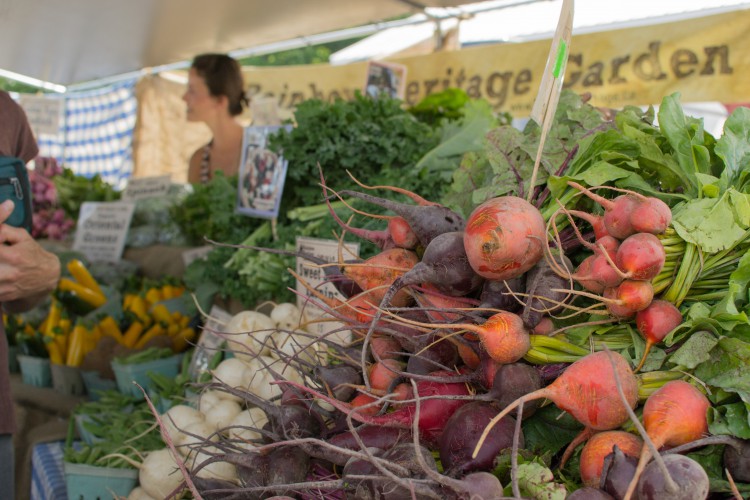How do you choose? Local vs organic food?
If you’ve attended our Eat By Design Seminar, you know that nutrient density is a BIG DEAL.
After all, that’s the whole purpose of eating right? To fulfill our requirements for fuel – macronutrients like fat, protein and carbohydrate, and micronutrients like essential vitamins and minerals. The best way to do that is to focus on consuming foods with the highest nutrient density and the least amount of toxicity.
During our local growing months, both criteria above are easy to satisfy: the North Shore’s farmers markets are filled with loads of high quality, local organic vegetables and fruit.
But what happens when that’s not the case? Like the months of October through June in Massachusetts. Often the choice between local non-organic (e.g. greenhouse/suntech varieties) vs imported organic can be tough.
Which is the better option?
While the primary argument FOR organic vegetables and fruit has largely been about eating foods without the pesticides, herbicides, and fungicides typically found in conventional produce, more recently the nutrient density argument has become a larger part of the conversation and has more scientific support than ever.
If you’re familiar with Eating By Design, you know that we are big proponents of buying organic for both of these reasons.
But what about in the middle of winter when the choice is organic vegetables from California or conventional greenhouse vegetables from Massachusetts?
Well, according to this Penn State article, for spinach and other greens, the reduction in nutrient quality was the same whether the product was organic or conventionally farmed.
So… Do you prioritize the ‘lowest toxicity’ part of the equation and buy the California organic (but take the hit on nutrient density) or do you risk the potential for higher toxicity with the benefit of substantially higher nutrient density?
From my perspective, there are arguments for both options and as yet no clear, objective way of deciding. It comes down to educating yourself and figuring out what you value most, and then making the best decision you can at that time.
Confused?
I get it. So was I.
I’ve been attempting to navigate the healthy-food landscape for the past 20 years and have likely struggled with the same problems you and your family face.
Through these struggles I’ve learned a lot about how to maximize your food quality while not breaking the bank.
LOCAL VS ORGANIC:
Here’s my 5 step hierarchy for choosing what, where and when to buy. If step 1 is not available and/or outside your budget, move to #2 and so on.
1. Local Outdoor + Organic
During the summer months (July-Oct) buy as much as possible from local organic producers available at a variety of Ottawa Farmer’s Markets.
2. Local Outdoor + No Pesticides/Herbicides (but not labeled organic)
A lot of smaller producers can’t afford the ridiculous regulatory fees required to be labelled as organic. While I like to support the ones who do invest in this process, in my experience, many of the non-labelled farms meet all the important criteria for ‘organic’.
3. Local Indoor/Greenhouse
Advances in hydroponic and indoor agriculture has dramatically reduced the use of most herbicides/pesticides while maintaining similar nutrient density to conventionally grown produce (outdoors). Here I prioritize nutrient density over toxicity.
Here’s a great example of a local indoor farming project:
4. Local Conventionally Grown
5. Imported Organic
Steps 4 and 5 are interchangeable and is when I really begin to consider toxicity as the primary factor.
Every year the Environmental Working Group releases 2 very handy lists called ‘The Dirty Dozen’ and ‘The Clean Fifteen.’ As you can probably guess, the dirty dozen list includes the top 12 foods with the highest herbicide/pesticide residue count and the clean fifteen are the 15 foods that have the least concentration.
This helps me to decide what I’m willing to buy local/conventional and what I’m going to pass by unless there’s an organic option. For example, I no longer buy conventional/non-organic kale even if its local and instead buy organic or go without. Conversely, something like avocados (where you don’t eat the skin and thus avoid the toxic residues) I’m ok with buying non-organic.
Still confused?
That’s what the Eat By Design Seminar is for!
To get you started on local vs organic, check our Eat By Design Quick Start Guide and see how you can make sure you’re satisfying your body’s core requirements for nutrients in the best possible way.
Dr. Derek Gallant
Dr. Derek Gallant has committed himself to helping others live the best life possible. After graduating from Wesleyan University, he received his Doctor of Chiropractic Degree from Life Chiropractic College West where he finished 2nd in his class. He is the owner of Beverly Family Chiropractic and co-founder of The Well Family Foundation. Dr. Gallant is certified through the International Chiropractic Pediatric Association (ICPA) in the Webster technique, an analysis focused on assisting pregnant women in a healthy pregnancy and natural birth. He has inspired thousands of people to take control of their own health using the Life By Design method. Apart from full time practice you can find Derek at the parks and coffee shops around Beverly with his family, training hard at the gym, or at the beach surfing.









